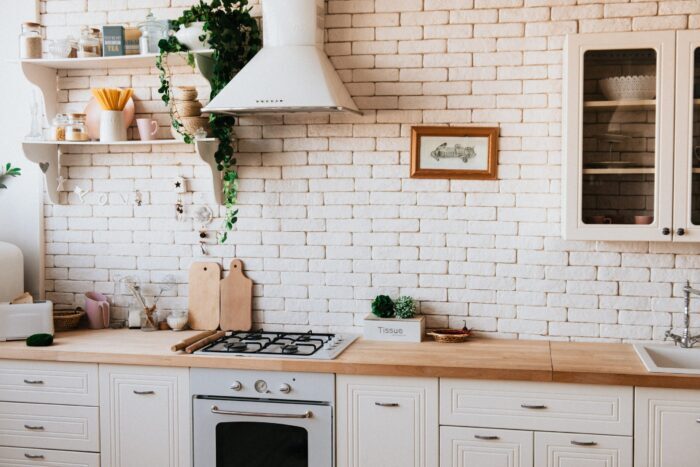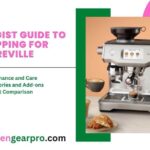Equipping your kitchen with the right tools is the first step toward good food. Whether you are organizing your kitchen for the first time or need to replace any worn-out things, investing in these kitchen items will make cooking a fun and simple hobby that you will love. Here are some of the essential kitchen utensils every cook should have.
Disclosure: As an Amazon Associate, we may earn an affiliate commission for purchases you make when using the links on this page.
Table of Contents
#1 Chef’s Knife
If you are going to cook, you will need a knife. A home chef’s best friend is a good knife, and it is one of the few items you will be glad to spend money on. Choose a knife that you seem to be comfortable with because you will be using it a lot. It should feel balanced, comfortable to grasp and handle in your hand, not too heavy, but not flimsy. Carbon-plated stainless steel knife will keep its sharpness over time.
If you have money and space for one knife, get a chef’s knife. Because you will be using this knife for 90 percent of your food prep, get a decent one and take care of it. I also suggest getting a serrated knife and a paring knife, as they serve different purposes. For example, serrated knives are suitable for slicing tomatoes and bread, while paring knives are ideal for smaller, more delicate tasks where a large knife would be ineffective.
#2 Kitchen Shears
Even if your kitchen is entirely stocked with the latest and greatest in cooking utensils, it never hurts to have a couple of shears around just in case. These versatile scissors are indispensable when it comes to all kinds of different tasks. For example, you will need shears on a daily basis to open packages, cut herbs, slice through pizza, remove fat from meats, and even cut the backbones out of chickens.
#3 Kitchen Spatulas
When purchasing new kitchen spatulas, the material is first to consider. How much time (or patience) you have to hand wash tools will determine which material is best for you. Some materials, such as silicone, can be washed in the dishwasher. On the other hand, wooden spatulas should never be put in the dishwasher. However, you must consider the type of cooking you will be doing as well as the pots and pans you will be utilizing.
A sturdy metal spatula should be part of any cook’s toolkit. It is often called a turner or flapper. It is used to turn or move food whenever you work with metal cookware. A robust metal spatula is essential for flipping, tossing, and serving many kinds of foods. Consider scrambled eggs, puffy pancakes, roasted vegetables, cooked meats, baked salmon, etc.
But for use with ceramic Dutch ovens and nonstick pans, you will need silicone or wooden spatulas. A silicone spatula is what you will use to scrape off every last drop of custard, batter, or sauce from the inside of a pot or bowl, rather than just turning and flipping with it. However, if your spatula is made of rubber instead of silicone, it may melt when exposed to intense heat.
#4 Cooking Tongs
Tongs are like an extra pair of hands that come in handy while cooking. As well as assisting with flipping ingredients in frying pans or on sheets of aluminum foil, they may be used to stir pasta, open wine bottles, serve salad and even reach those hard-to-reach places in your cupboards with them. They are also perfect for serving family-style during a dinner party or picnic. If you use them, you will avoid numerous cooking mishaps.
The 12-inch tongs are suitable for regular use, while the 14-inch tongs are perfect for grilling. It is also critical that they have silicone tips to minimize scratching and a high level of heat resistance so that they do not melt away after repeated usage.
#4 Y‑shaped Peeler
A Y‑peeler is a vegetable peeler with horizontal blades at the top of a y‑shaped handle. The edge of this peeler is perpendicular to the handle, unlike most other types. The peelers may save you time while peeling potatoes, carrots, or other vegetables. However, the one with serrated blades comes in handy for peeling softer skins and slicing citrus fruit. Always ensure you have a nice, sharp peeler that could shave off the cheese or make vegetable ribbons while making up a fancy and healthy meal.
#5 Can Opener
A can opener is an essential kitchen tool that you should always have on hand whenever you need to open a canned product. The main thing to consider while purchasing a can opener is that it should be capable of opening a can easily, do not create hand pains, and do not leave sharp edges at the top of the can is to consider. First, it is a simple request, but many can openers on the market cannot do it. Secondly, it must be easy to set up and use with no complicated processes, and finally, it should be long-lasting.
#6 Medium Box Grater
Graters are that may be an asset in any kitchen, from slicing cheese to mincing garlic. The typical box grater has two sides with holes for grating (one large and one small), one side is for slicing like a mandoline, but not as sharp, and the last side has tiny punched-out holes for zesting or very finely grating.
It is simple to store and use box graters since they are resilient, lightweight, dishwasher safe, and can be used for various purposes. Box graters are simple to use but can be challenging to clean. Food can quickly accumulate on the surface of the grooves, which can be difficult to reach. Cheese, for instance, clings to the box grater and, if left too long, it hardens. Clean it quickly after each usage to keep it in good condition. Wash with a brush or rough sponge in hot, soapy water.
#7 Garlic Press
A garlic press is a useful cooking gadget that you will use more often than you think. It came out useful for producing evenly “minced” garlic that is considerably smaller than what we might do by hand. A garlic press also comes in handy when we need to crush a large amount of garlic together.
It is perfect for those of us who adore garlic flavor in every meal or if you are a little self-conscious about your knife skills. Toasted garlic bread, garlic shrimp, and other quick and easy dishes benefit from the convenience of this portable tool.
#9 Measuring Spoons
A measuring spoon is a kitchen utensil ranging from one tablespoon or 15 ml in size. It holds a specific amount of dry and liquid ingredients. The smallest spoon measurements are a smidgeon, a pinch, and a dash. Other sets include teaspoon (tsp) and tablespoon (tbsp) measures. They come in many different sizes and materials, and typically, they are constructed of plastic or metal.
#10 Measuring Cups
Measuring cups are used to measure out the proper amount of ingredients that one might need when cooking. A number of things should be considered when buying kitchen measuring cups. First, you need to decide if you need to measure dry or liquid ingredients, the material it is made from (plastic, metal, and glass), and the ease of use (for example, does it have a handle or a pour spout). Next, consider how accurate they are (measuring liquid or flour) and how easy they are to read.
#11 Instant-Read Thermometer
In any home kitchen, an instant-read thermometer is essential. This tool assures that everything you are about to eat or serve has been cooked to a safe temperature, safeguarding you and your family from foodborne illnesses such as salmonella, etc.
#12 Colander
Essential cooking equipment, the colander, is most often used for rinsing vegetables or straining pasta. It is similar to a strainer and is usually composed of a light metal like aluminum or thinly rolled stainless steel. However, it can also be constructed of plastic or silicon. A colander is pierced with a sequence of tiny holes to allow the liquid to drain while the particles remain inside the sieve.
Final Thoughts
Kitchenware does not have to be difficult or expensive to fill a minimalist and efficient kitchen. You can end up with a fully stocked kitchen that will last a lifetime by purchasing only high-quality multi-purpose goods with a strong value proposition.




